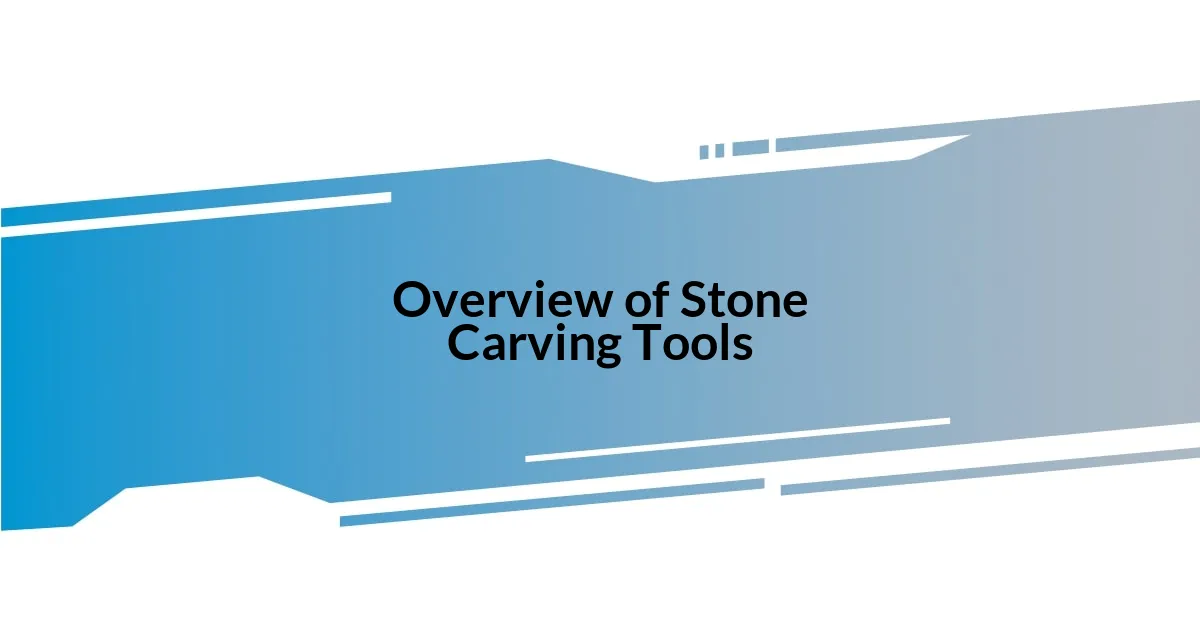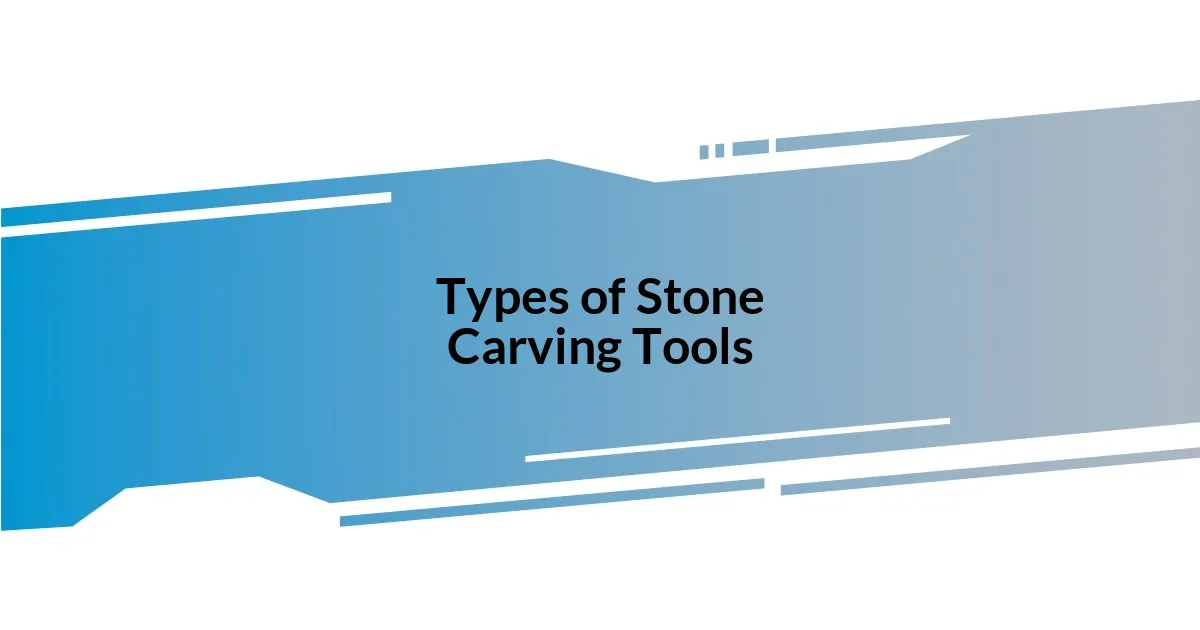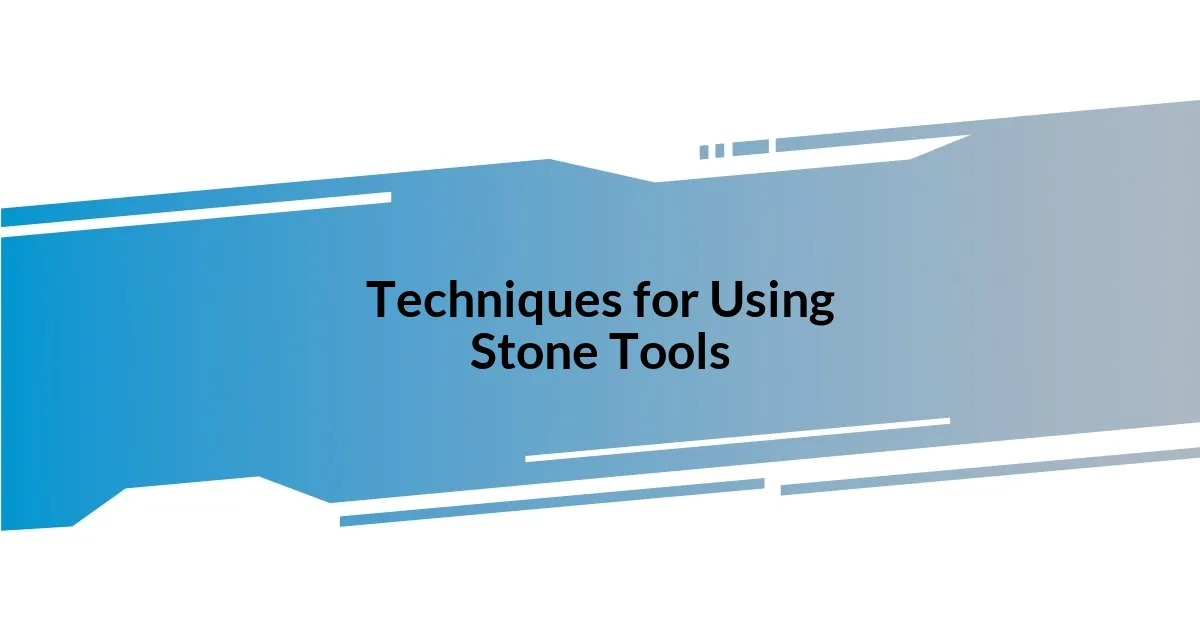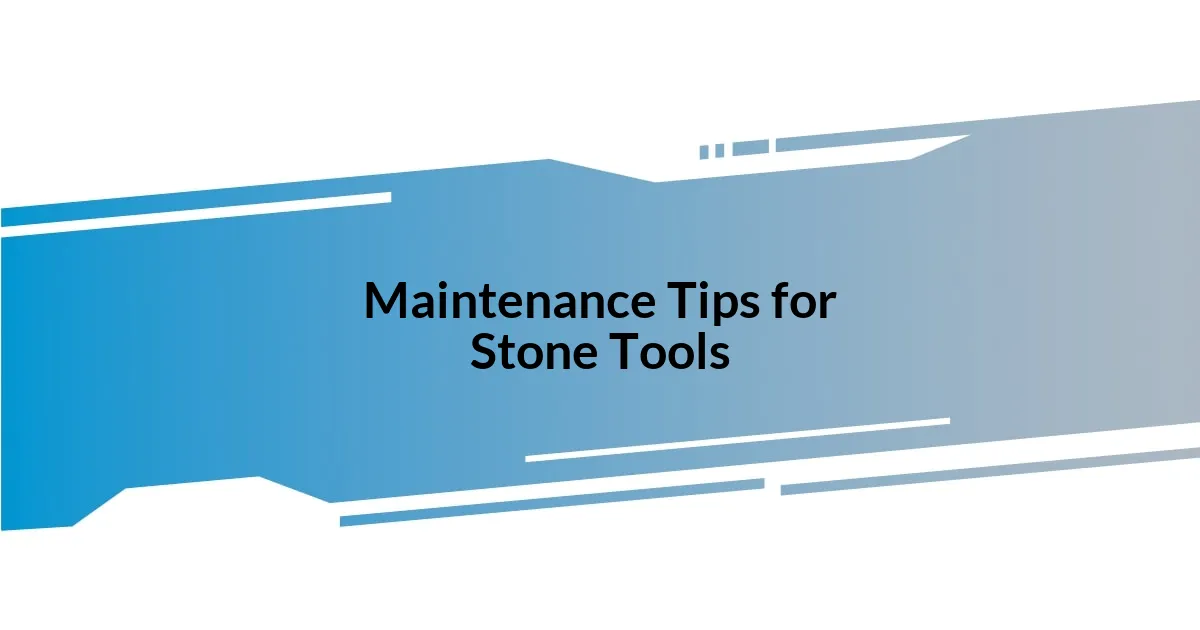Key takeaways:
- Stone carving tools, such as chisels and hammers, are essential extensions of the artist’s creativity, each influencing the final artwork’s texture and detail.
- Beginners should prioritize key tools like the point chisel, flat chisel, rasp, and hammer, as they significantly enhance the carving process and outcomes.
- Effective carving techniques include applying gentle pressure, assessing work from different angles, and finding a consistent rhythm to improve precision and artistic connection.
- Regular maintenance, including cleaning and sharpening tools, is crucial for their longevity and performance, while proper storage protects them from damage.

Overview of Stone Carving Tools
When I first delved into stone carving, I realized that tools are the artist’s extension. Chisels, hammers, and rasps became a part of my creative expression. Each tool has its own personality, influencing the texture and detail of my work.
For instance, I remember the first time I used a point chisel. The precise strikes felt almost exhilarating, transforming a block of rough granite into something with potential. It was an eye-opening experience—how can a simple tool in the right hands create magic?
Then there’s the joy of using a flat chisel, which allows for wider, cleaner cuts. I often found myself in a rhythm while carving, feeling completely in sync with the stone. Have you ever felt that connection when working with your hands? For me, those moments are where the essence of stone carving truly lies.

Types of Stone Carving Tools
When it comes to stone carving tools, the variety available can be quite overwhelming. My go-to tools include the point chisel, flat chisel, and various hammers, each serving a distinct purpose. I recall a time when I needed to soften a rough edge. The flat chisel made the task not only easier but also more satisfying to behold as the stone transformed under my hands.
Another essential tool in my arsenal is the rasp. This tool has a unique ability to refine details and achieve smooth finishes. I remember spending hours with a rasp, gradually revealing the intricate patterns hidden within the stone. The feeling of complimenting the chisel’s work with a rasp is akin to a painter fine-tuning their brushstrokes—there’s a depth of connection that’s hard to describe.
Lastly, I can’t overlook the importance of a sturdy hammer, often overlooked by beginners. My first experience with a stone hammer felt empowering. The rhythm of my strikes resonated not only within the stone but in my heart too. It’s through this forge of tools that I’ve crafted my artistic identity, each piece reflecting my journey through stone and self-discovery.
| Type of Tool | Purpose |
|---|---|
| Point Chisel | Used for removing large amounts of stone quickly and creating initial shapes. |
| Flat Chisel | Ideal for making flat surfaces and sharper outlines. |
| Rasp | Perfect for refining details and achieving a smooth finish. |
| Hammer | Essential for striking chisels and driving them into stone. |

Essential Tools for Beginners
When I began my stone carving journey, a few essential tools quickly revealed themselves as my best friends. I remember standing in my workshop, the smell of fresh stone dust filling the air, and feeling an excited flutter in my chest as I reached for my first set of tools. These instruments of creation were not just tools; they became my companions, each offering its unique assistance in the pursuit of my vision.
Here’s a quick overview of the essential tools every beginner should consider:
-
Point Chisel: This tool is your best bet for removing large quantities of stone. Initially, it can feel like wielding a magic wand as it swiftly carves away the rough edges.
-
Flat Chisel: As you progress, you’ll appreciate the flat chisel for its ability to create clean, defined surfaces. I often found it comforting to see the precision it brought to my work.
-
Rasp: Trust me, the rasp is a game-changer when it comes to honing in on those intricate details. I cherish the moments spent with a rasp, transforming a rough form into something remarkably smooth.
-
Hammer: You can’t overlook a sturdy hammer; it’s a foundational tool that sets your strikes in motion. The rhythmic sound of metal on stone was music to my ears, syncing my heartbeat with every tap.
With these tools in hand, your stone carving adventure can genuinely unfold, unveiling a world of creativity you might not have expected.

Advanced Tools for Professionals
When you reach a certain level in stone carving, the tools you use often become an extension of your own creative expression. I vividly remember the first time I held an angle grinder. It felt like I had harnessed a new power. This tool isn’t just for shaping stone; it allows for precision cuts and can create intricate details that hand tools sometimes struggle to achieve. Have you ever felt that rush of inspiration when you make a clean cut? It’s truly exhilarating.
Then there are pneumatic chisels. These are a game-changer for those long, detailed hours at the carving block. I still recall the day I switched from hand chiseling to a pneumatic chisel. The speed and efficiency made me wonder why I didn’t try it sooner! The tool seemed to breathe new life into my work, reducing fatigue while enhancing my focus on artistic nuances rather than the physical toll of the effort.
Finally, let’s not forget the importance of diamond blades. I once underestimated their capabilities until I used one on a particularly tough stone. It cut through with such ease that I felt like I was dancing along the surface rather than working against it. Investing in advanced tools like these can truly elevate your craft, allowing you to explore your artistic boundaries and express yourself more fully. So, what tools have transformed your own creative journeys?

Techniques for Using Stone Tools
Using stone tools effectively centers around mastering techniques that enhance both creativity and precision. One technique I found invaluable was the practice of gentle pressure. Early in my carving days, I had a tendency to apply too much force, which often led to unwanted breaks or cracks in the stone. Over time, I learned that a lighter touch could yield better results, allowing me to achieve finer details without compromising the integrity of my materials. Have you experienced that moment of realization when less truly becomes more?
Another crucial technique is to frequently assess your work from different angles. I remember a time when I was so focused on one side of a sculpture that I failed to notice an uneven surface on the other. Stepping back and viewing the piece from afar not only helped me identify areas needing refinement but also recharged my artistic perspective. It’s a simple yet effective method that can make a world of difference—do you take that important step back during your carving process?
Lastly, incorporating a consistent rhythm into your chiseling can transform your workflow. When I found my cadence, each strike felt more deliberate and purposeful. It was like a dance between my tools and the stone, creating a harmonious flow in my work. This rhythm not only improved my efficiency but also deepened my connection to the stone, making each cross-section reveal something new. So, how do you find your groove when working with stone?

Maintenance Tips for Stone Tools
Maintaining your stone carving tools is just as vital as the carving itself. Regularly cleaning them after each session has become a part of my routine. I recall a time when I neglected to wipe down my chisels, only to find rust spots appearing later. It’s a painstaking process to restore them, so now I make it a point to give them a good scrub with a soft brush and some oil. Have you ever thought about how a few extra minutes of care could extend the life of your tools significantly?
Another aspect of maintenance is sharpening. I remember my first attempts with a sharpening stone—it was messy, and honestly, a bit frustrating. But once I got the hang of it, the difference in performance was astonishing. A well-sharpened chisel glides effortlessly through stone, making every cut cleaner and more precise. So, how often do you sharpen your tools? Trust me, it’s a habit that pays off in the quality of your work.
Storage is another critical area I learned the hard way. Initially, I would toss my tools haphazardly into a drawer, resulting in dings and scrapes. Now, I store them in a padded case, with each tool in its designated spot. This not only protects them but also makes my workflow smoother when I can easily find the right tool. Have you considered how your storage solutions could impact your carving experience? Investing in proper storage can save you time and keep your tools in top shape for years to come.

Personal Insights on My Experience
Working with stone carving tools has been a deeply personal journey for me. I still vividly remember my first project—a small, rough-hewn owl. As I chipped away at the stone, I was filled with a mixture of excitement and trepidation. Would I be able to bring this creature to life? Each strike of the chisel felt like a conversation with the stone itself, and that experience instilled a sense of connection that I cherish to this day. Have you ever felt that pulse of anticipation when beginning a new piece?
Another realization I’ve had along the way is the importance of patience. I recall a moment of frustration while trying to carve intricate feathers; I kept rushing through the details and it showed in the final piece. Stepping back, I took a deep breath and reminded myself that great work takes time. The moment I slowed down, I noticed how much beauty can be found in the subtleties of stone. It’s a lesson that transcends beyond just carving—how often do we forget the value of patience in our lives?
Finally, I’ve discovered that each tool has its own character and personality. My favorite chisel, for example, feels like an extension of my own hand. I remember a day when I was working on a particularly stubborn piece, and instead of forcing it, I decided to let the chisel guide me. It was as if the stone whispered secrets of its own, leading me to unexpected discoveries that I would have otherwise overlooked. Have you ever had that magical moment when intuition takes over, transforming the challenge into an artistic revelation?